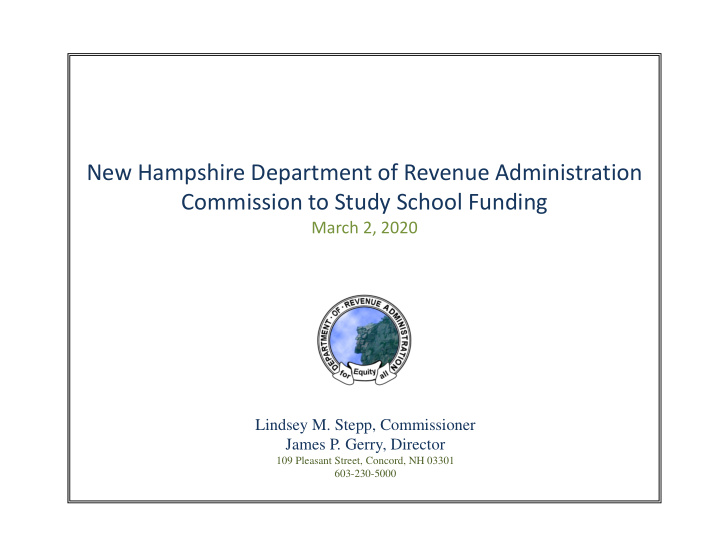



New Hampshire Department of Revenue Administration Commission to Study School Funding March 2, 2020 Lindsey M. Stepp, Commissioner James P. Gerry, Director 109 Pleasant Street, Concord, NH 03301 603-230-5000
MISSION The mission of the Department of Revenue Administration is to fairly and efficiently administer the tax laws of the State of New Hampshire, collecting the proper amount of taxes due, incurring the least cost to the taxpayers, in a manner that merits the highest degree of public confidence in our integrity. Further, we will provide prompt and constructive assistance to the municipal units of government in matters of budget, finance, and the appraisal of real estate. 2
3
Municipal and Property Division • Establishes and approves municipal, school, county and village district tax rates. • Provides technical assistance and training in all aspects of municipal finance and budgeting. • Monitors reappraisals and certifies tax assessors. • Equalizes local assessed values of municipalities to full value. • Appraises public utility and railroad property for the administration of corresponding taxes. • Administers timber and gravel taxes. • Provides support for statutorily attached boards (Assessing Standards Board and Current Use Board). 4
Appropriations Approved by School District Voters are Funded by: • Local Education Property T axes • State Education T ax/Statewide Education Property T ax (SWEPT) • Education Grants from the Education Trust Fund • Other revenue (non-property revenues from federal, state, and/or local sources, use of retained fund balance, etc.) 5
Appropriations Approved by School District Voters are Funded by: • Local Education Property T axes axpayer Municipality School District • T • Statewide Education Property T ax (SWEPT) axpayer Municipality School District • T • Education Grants from the Education Trust Fund • State School District • Other revenue (non-property revenues from federal, state, and/or local sources, use of retained fund balance, etc.) • Various Sources School District 6
Appropriations Approved by School District Voters are Funded by: • Local Education Property T axes axpayer Municipality School District • T • Determined by the difference between total appropriations and three other funding sources • Statewide Education Property T ax (SWEPT) axpayer Municipality School District • T • Determined by statute (RSA 76:3) • Calculation performed by DRA • Education Grants from the Education Trust Fund • State School District • Determined by statute including cost of adequate education, with amount of SWEPT raised and retained locally subtracted from the total cost of an adequate education, stabilization grants, and additional aid (FY2021) • Other revenue (non-property revenues from federal, state, and/or local sources, use of retained fund balance, etc.) • Various Sources School District • Determined by circumstances that can vary year to year 7
The History of the Statewide Education Property Tax in N.H. • 1999 –SWEPT created (using set rates in the statute) –Laws of 1999, Chapter 17. The “annual education property tax” was set at $6.60 on each $1,000 of value of taxable property. • 1999 –Utility Property Tax enacted by Laws of 1999, Chapter 17. This created RSA Chapter 83-F , setting the utility property tax at a rate of $6.60 on each $1,000 of value of taxable property. • 2001 –Laws of 2001, Chapter 158 set the “annual education property tax” rate at $5.80. • 2003 –Laws of 2003, Chapter 241, set the “annual education property tax” rate at $4.92. 8
The History of the Statewide Education Property Tax in N.H. (continued) • 2004 –Laws of 2004, Chapter 195, set the “annual education property tax” rate at $3.24. The law also introduced an approach, beginning July 1, 2005, which would set a rate to raise a specific dollar amount ($363,677,547). • 2005 –Laws of 2005, Chapter 257 introduces a change and now requires that the “statewide enhanced education tax rate” be set each year “at a level sufficient to generate revenue of $363,000,000…” • 2008 –Laws of 2008, Chapter 257 change name of tax to “education tax” . • 2011 –Laws of 2011, Chapter 258 -Previous requirement that “excess” SWEPT taxes at local level be returned to the State is eliminated. 9
Current Law 10
How SWEPT is Calculated • Using Unity, NH and the calculation of their 2019 SWEPT as an example. • The Department’s Equalization Bureau must first complete the equalization of each municipalities’ property values pursuant to RSA 21-J:3, XIII. This equalized valuation will be available by June of 2018 for the property values reported in 2017. • The Department’s Municipal Bureau then utilizes the total equalized valuation for all municipalities to determine the “uniform education rate” necessary to raise at least $363,000,000 (calculated to the nearest half cent). 11
How SWEPT is Calculated (continued) • T otal equalized valuation as of 4/1/2017 was $176,333,020,837, which resulted in a “uniform education rate” of $2.060 per $1,000 of value for the tax year beginning 4/1/2019. • Taking the “uniform tax rate” of $2.060 per $1,000 of value the amount of SWEPT that Unity was expected to raise was $250,832 12
How SWEPT is Calculated (continued) • The Education Tax Warrant required that the T own of Unity assess and collect $250,832. 13
How SWEPT is Calculated (continued) • In order to assess this $250,832 among the various taxpayers in Unity, the T own will create a Unity-specific Education Tax Rate by dividing the needed tax dollars by the T own’s local calculation of property valuation (130,295,397). 14
Sources of Education Revenue Unity School District 2019 How to Pay for “Fund” the Appropriations Amount What % of Appropriations (Approved by Voters) ($3,663,106) Local Education Property Taxes $2,013,300 55.0% Paid via Tax Bill State Education Grant – State Pays to School District $890,141 24.3% SWEPT – Taxpayers Pay to School District via Tax Bill $250,832 6.8% Non-Property Revenues Received by School from $204,932 5.6% Federal Sources Non-Property Revenues Received by School from $187,999 5.1% State Sources School District – Retained Fund Balance Use $73,402 2.0% Non-Property Revenues Received by School from $42,500 1.2% Local Sources 15
SWEPT by County 16
Recommend
More recommend